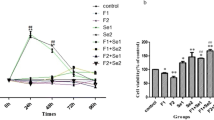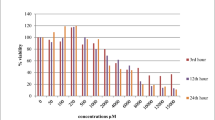Abstract
The effects of the element fluorine on the phosphoinositide-3-kinase–protein kinase B/Akt (PI3K/Akt) pathway has a significant role in regulation of intracellular molecular mechanisms. NRK-52E rat kidney epithelial cell line was selected as the material of the study. NaF was used as the fluorine source in the study. The NaF dose was determined with the MTT assay. The NaF concentrations were determined as the proliferation concentration of 10 μM and IC25 (2250 μM) and IC50 (4250 μM) for 24 h. In the study, the erb-b2 receptor tyrosine kinase 2 (ERBB2), phosphoinositide-3-kinase (PI3K), Protein kinase B (PKB,Akt), Mammalian target of rapamycin (mTOR), and the Tumor protein 53 (TP53) genes were considered as the target genes. NaF concentration was administered on the cells. Total mRNA was isolated. mRNAs were turned into cDNA. The expression levels of the target genes were determined by RT-qPCR method. According to the results obtained in the study, the low NaF concentration increased the expression levels of the ERBB2, PI3K, and Akt genes, while the higher concentrations did not significantly affect these levels. The expression of mTOR decreased at all given concentrations. The expression of the TP53 gene did not change at the low concentration, while it increased at the high concentrations. Based on the results, it may be stated that fluorine may inhibit the kinase enzymes in the PI3K/Akt pathway. In summary, in the pathogenesis of the cell damage caused by fluorine in the NRK-52E cell line, the PI3K/Akt/mTOR pathway is an important signal pathway.




Similar content being viewed by others
Data Availability
The datasets used or analyzed in this study are available from the corresponding author on reasonable request.
References
Song GH, Gao JP, Wang CF, Chen CY, Yan XY, Guo M, Wang Y, Huang FB (2014) Sodium fluoride induces apoptosis in the kidney of rats through caspase-mediated pathways and DNA damage. J Physiol Biochem 70(3):857–868
Ergin E, Eden E (2017) Does fluorine have a negative effect on human health? J Ege Uni Faculty of Dent 201738(1):13–20
Agalakova NI, Gusev GP (2012) Molecular mechanisms of cytotoxicity and apoptosis induced by inorganic fluoride. Int Schol Res 2012:Article ID 403835
Song GH, Huang FB, Gao JP, Liu ML, Pang WB, Wb Li, Yan XY, Huo MJ, Yang X (2015) Effects of fluoride on DNA damage and caspase-mediated apoptosis in the liver of rats. Biol Trace Elem Res 166(2):173–182
Caglayan C, Kandemir FM, Darendelioğlu E, Küçükler S, Ayna A (2021) Hesperidin protects liver and kidney against sodium fluoride-induced toxicity through anti-apoptotic and anti-autophagic mechanisms. Life Sci 281:119730
Hemmings BA, Restuccia DF (2012) Pi3k-pkb/akt pathway. Cold Spring Harbor perspectives in biology 4(9):a011189
Yüksek V, Dede S, Taşpınar M, Çetin S (2017) The effects of certain vitamins on apoptosis and DNA damage in sodium fluoride (NaF) administered renal and osteoblast cell lines. Fluoride 50(3):300–313
Chomczynski P, Mackey K (1995) Modification of the TRI reagent procedure for isolation of RNA from polysaccharide- and proteoglycan-rich sources. Biotechniques 19(6):942–945
Livak KJ, Schmittgen TD (2011) Analysis of relative gene expression data using real-time quantitative PCR and the 2− ΔΔCT method. Methods 25(4):402–408
Anuradha CD, Kanno S, Hirano S (2001) Oxidative damage to mitochondria is a preliminary step to caspase-3 activation in fluoride-induced apoptosis in HL-60 cells. Free Radical Biol Med 1:367–373
Bai C, Chen T, Cui Y, Gong T, Peng X, Cui HM (2010) Effect of high fluorine on the cell cycle and apoptosis of renal cells in chickens. Biol Trace Elem Res 138(1–3):173–180
Barbier O, Arreolar-Mendoza L, Del Roza LM (2010) Molecular mechanisms of fluoride toxicity. Chem-Biological Interactions 188:319–333
Xu H, JinXQ JL, Li GS (2006) Effect of sodium fluoride on the expression of bcl2 family and osteopontin in rat renal tubular cells. Biol Trace Elem Res 109(1):55–60
Guney M, Oral B, Demirin H, Karahan N, Mungan T, Delibas N (2007) Protective effects of vitamins C and E against endometrial damage and oxidative stress in fluoride intoxication. Clin Exp Pharmacol Physiol 34(5–6):467–674
Çetin S, Yur F, Taşpinar M, Yüksek V (2019) The effects of some minerals on apoptosis and DNA damage in sodium fluoride-administered renal and osteoblast cell lines. Fluoride 52(3):362–378
Yüksek V, Dede S, Usta A, Çetın S, Taşpınar M (2020) DNA damage-induced by sodium fluoride (NaF) and the effect of cholecalciferol. Biocell 44(2):263–268
Pompura SL, Dominguez-Villar M (2018) The PI3K/AKT signaling pathway in regulatory t-cell development, stability, and function. J Leukoc Biol 103:1065–1076
He H, Wang H, Jiao Y, Ma C, Zhang H, Zhou Z (2015) Effect of sodium fluoride on the proliferation 352 and gene differential expression in human RPMI8226 Cells. Biol Trace Elem Res 167(1):11–17
Otsuki S, Morshed SR, Chowdhury SA, Takayama F, Satoh T, Hashimoto K, Sugiyama K, Amano O, Yasui T, Yokote Y, Akahane K, Sakagami H (2005) Possible link between glycolysis and apoptosis induced by sodium fluoride. J Dent Res 84(10):919–923
Gutowska I, Baranowska-Bosiacka I, Siwiec E, Szczuko M, Kolasa A, Kondarewicz A et al (2016) Lead enhances fluoride influence on apoptotic processes in the HepG2 liver cell line. Toxicol Ind Health 32(3):517–525
Viñals F, Testar X, Palacín M, Zorzano A (1993) Inhibitory effect of fluoride on ınsulin receptor autophosphorylation and tyrosine kinase activity. Biochem J 291(Pt 2):615–622
Urut F, Dede S, Yuksek V, Cetin S, Usta A, Taspinar M (2021) In vitro evaluation of the apoptotic, autophagic, and necrotic molecular pathways of fluoride. Biol Trace Elem Res 199(10):3700–3706
Efe U, Dede S, Yüksek V, Çetin S (2021) Apoptotic and oxidative mechanisms in liver and kidney tissues of sheep with fluorosis. Biol Trace Elem Res 199:136–141
Ameeramja J, Panneerselvam L, Govindarajan V, Jeyachandran S, Baskaralingam V, Perumal E (2016) Tamarind seed coat ameliorates fluoride induced cytotoxicity, oxidative stress, mitochondrial dysfunction and apoptosis in A549 cells. J Hazard Mater 15(301):554–565
Penuel E, Schaefer G, Akita RW, Sliwkowski MX (2001) Structural requirements for ErbB2 transactivation. Semin Oncol 28(6 Suppl 18):36–42
Wichmann H, Güttler A, Bache M, Taubert H, Vetter M, Würl P, Holzhausen HJ, Eckert AW, Kappler M, Vordermark D (2014) Inverse prognostic ımpact of ErbB2 mRNA and protein expression level in tumors of soft tissue sarcoma patients. Strahlenther Onkol 190(10):912–918
Zhou BH, Tan PP, Jia LS, Zhao WP, Wang JC, Wang HW (2018) PI3K/AKT signaling pathway involvement in fluoride-induced apoptosis in C2C12 cells. Chemosphere 199:297–302
Kuang P, Deng H, Liu H, Cui H, Fang J, Zuo Z, Deng J, Li Y, Wang X, Zhao L (2018) Sodium fluoride induces splenocyte autophagy via the mammalian targets of rapamycin (mTOR) signaling pathway in growing mice. Aging (Albany NY) 10(7):1649–1665
Huang Y, Sun M, Li F, Li H, Jiang Z (2018) Preliminary study of mechanisms of fluoride-induced suppression of nitric oxide synthesis in human umbilical vein endothelial cells. Biol Trace Elem Res 185(2):311–315
Fan B, Yu Y, Zhang Y (2015) PI3K-Akt1 expression and its significance in liver tissues with chronic fluorosis. Int J Clin Exp Pathol 8(2):1226–1236
Shenoy PS, Sen U, Kapoor S, Ranade AV, Chowdhury CR, Bose B (2019) Sodium fluoride induced skeletal muscle changes: degradation of proteins and signaling mechanism. Environ Pollut 244:534–548
Guo Q, Sun Z, Niu R, ManthariRK Yuan M, Yang K, Cheng M, Gong Z, Wang J (2020) Effect of arsenic and/or fluoride gestational exposure on renal autophagy in offspring mice. Chemosphere 241:124861
Zhang J, Zhu Y, Shi Y, Han Y, Liang C, Feng Z, Zheng H, Eng M, Wang J (2017) Fluoride-induced autophagy via the regulation of phosphorylation of mammalian targets of rapamycin in mice leydig cells. J Agric Food Chem 65(40):8966–8976
Lei S, Zhang Y, Zhang K, Li J, Liu L (2015) Effects of fluoride on the expression of Beclin1 and mTOR in ameloblasts. Cells Tissues Organs 200(6):405–412
Suzuki M, Ikeda A, Bartlett JD (2018) Sirt1 overexpression suppresses fluoride-induced p53 acetylation to alleviate fluoride toxicity in ameloblasts responsible for enamel formation. Arch Toxicol 92(3):1283–1293
Tu W, Zhang Q, Liu Y, Han L, Wang Q, Chen P, Zhang S, Wang A, Zhou X (2018) Fluoride induces apoptosis via inhibiting SIRT1 activity to activate mitochondrial p53 pathway in human neuroblastoma SH-SY5Y cells. Toxicol Appl Pharmacol 347:60–69
Luo Q, Guo H, Kuang P, Cui H, Deng H, Liu H, Lu Y, Wei Q, Chen L, Fang J, Zuo Z, Deng J, Li Y, Wang X, Zhao L (2018) Sodium fluoride arrests renal G2/M phase cell-cycle progression by activating ATM-Chk2-P53/Cdc25C signaling pathway in mice. Cell Physiol Biochem 51(5):2421–2433
Wen P, Wei X, Liang G, Wang Y, Yang Y, Qin L, Pang W, Qin G, Li H, Jiang Y, Wu Q (2019) Long-term exposure to low level of fluoride induces apoptosis via p53 pathway in lymphocytes of aluminum smelter workers. Environ Sci Pollut Res Int 26(3):2671–2680
Funding
This study was supported by a Grant from the Scientific Research Projects Presidency of Van Yüzüncü Yil University (TYL-2019–822.
Author information
Authors and Affiliations
Contributions
All authors contributed to the study’s conception and design. Material preparation, data collection, and analysis were performed by Rıskiye Korkmaz, Veysel Yüksek, and Semiha Dede. The first draft of the manuscript was written by Rıskiye Korkmaz, and all authors commented on the previous versions of the manuscript. All authors read and approved the final manuscript.
Corresponding author
Ethics declarations
Ethical Approval
Not applicable.
Consent to Participate
Not applicable.
Consent to Publish
Not applicable.
Conflict of Interest
The authors declare no competing interests.
Additional information
Publisher's Note
Springer Nature remains neutral with regard to jurisdictional claims in published maps and institutional affiliations.
Rights and permissions
About this article
Cite this article
Korkmaz, R., Yüksek, V. & Dede, S. The Effects of Sodium Fluoride (NaF) Treatment on the PI3K/Akt Signal Pathway in NRK-52E Cells. Biol Trace Elem Res 200, 3294–3302 (2022). https://doi.org/10.1007/s12011-021-02927-4
Received:
Accepted:
Published:
Issue Date:
DOI: https://doi.org/10.1007/s12011-021-02927-4




